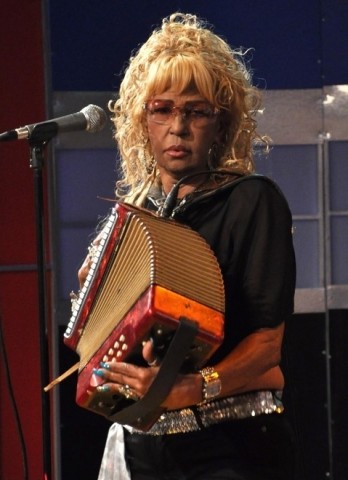By: Chelsea Vargas | Date Added:

Manuela Josefa Cabrera Taveras, widely known as Fefita La Grande, is a Dominican accordionist and the most recognized female performer of Merengue Tipico (also known as ‘Perico Ripiao’), a more rural variation of merengue, the main musical genre of the Dominican Republic. She is one of the greatest representatives of the "Tipico genre" paving the way for countless other Dominican women who dreamed of pursuing a career in music, in an otherwise male dominated scene. Her version of the song "La chiflera" is an emblem of Tipico music. Fefita grew up in a musical yet impoverished household. Her father, Eliseo ‘Seito’ Cabrera was an accordionist himself, owned an instrument repair shop, and also worked as a farmer. Fefa, or Fefita (short for Josefa) grew up surrounded by the sounds of her father’s accordion, and by those of the other instruments in his shop. At age seven, after hearing one of Guandulito’s recordings, one of the male pioneers of Merengue Tipico, Fefita made up her mind to learn to play accordion and sing. Her parents encouraged her interest in music, and when Fefita was nine years old, she formed a band with other schoolmates. Fefita’s band played at local events, and she grew to be something of a celebrity in her small town. People were taken by the precocious young girl singing and playing merengues on accordion. This success further motivated Fefita to pursue the dream of becoming a professional Merenguera. Throughout her youth, Fefita continued to play locally and to learn from her father. By the mid-1970s, Fefita was performing in larger events, and in 1976 her career took off when she toured with Rafael ‘El Maestro’ Solano. Her partnership with Solano took her abroad, and they were the first Dominicans to perform Merengue Tipico in Europe. Around that time, she was approached by a businessman named Teodoro, who offered to produce her first album. She didn’t need any convincing and quickly began her career as a recording artist. Her debut album, ‘Si Quiere Venir Que Venga’ was a huge success, and was followed by other hits like ‘Fiesta en San Jose’, ‘El Hombre Que Yo Mas Quise’, ‘La Pimienta Es La Que Pica’, and ‘Vamonos Pal Can’. She covers old merengues in some of her recordings, including a few of her father’s, but her talents as a songwriter mark her individuality as an artist. Fefita captivates audiences with her fiery riffs, and affable stage chatter. Despite her virtuosity, she respects Merengue Tipico’s traditional roots, and criticizes musicians who show off by playing too fast. She says she does Meregue “the straight way, the way Tatico Henriquez did.” Fefita plays Tipico in the modern format that Tatico pioneered: two saxophones, congas, and an electric bass, in addition to the traditional accordion, tambora, and guira. Throughout her career, Fefita La Grande has garnered awards and accolades. Her iconic popularity has taken her to Dominican cinema. She plays herself as well as other characters in ‘Nueba Yol 3: Bajo la nueva ley’ (1997), ‘Perico Ripiao’ (2003), and ‘Ponchao’ (2013). In 2012, news leaked that Fefita had been fighting breast cancer for some time, but that it was caught on time. Nothing seems to stop Fefita La Grande. With a clean bill of health from her doctors, and a work visa from the United States, Fefita expects to continue her active career. She admires young Merengueras such as Maria Diaz, Meri Hernandez and Raquel Arias, and hopes that they and many other women will continue in her footsteps.
click hereShare your thoughts on this story with us. Your comments will not be made public.
Email
Copyright ©2016 - Design By Bureau Blank